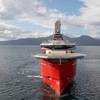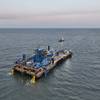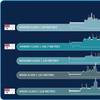U.S. Ports Plan Big Investments in Capital Projects - Survey
Survey Shows U.S. Ports Plan Big Investments In Capital Projects. Anticipated federal under-investment in port-related infrastructure could dampen job and economic prospects
In its just-released 2016-2020 Port Planned Infrastructure Investment Survey, the American Association of Port Authorities (AAPA) – the unified and recognized voice of seaports in the Americas – asked its U.S. member ports how much they and their private-sector partners plan to spend on port-related freight and passenger infrastructure over the next five years. The answer was a whopping $154.8 billion.
AAPA then contrasted that number with what it believes is the “best-case” scenario for investments by the federal government into U.S. ports, including their land- and water-side connections, through 2020. The answer was just $24.825 billion.
According to AAPA President and CEO Kurt Nagle, the vast difference between the two investment numbers poses tangible concerns, particularly considering the need to increase government investments in America’s federal navigation channels and the “first-and-last mile” connections with ports. It’s vital, he noted, that the federal government uphold its end of the partnership.
“Infrastructure investments in America’s seaports and their intermodal connections – both on the land and in the water – are in our nation’s best interest because they provide opportunities to bolster our economy, create and sustain jobs, enhance our international competitiveness, and pay annual dividends through the generation of more than $321 billion in federal, state and local tax revenue,” said Mr. Nagle. “From a jobs standpoint, goods moved through America’s seaports in 2014 supported employment of more than 23 million U.S. workers … up from 13.3 million in 2007.”
Economist John C. Martin, Ph.D., president of Lancaster, Pa.-based Martin Associates, said U.S. Bureau of Economic Analysis formulas show that investing nearly $155 billion in capital projects at U.S. ports would create about 1.6 million direct, indirect and induced domestic jobs, accounting for approximately 3.3 billion person-hours of work over the period of the investment.
“Those are really significant job numbers,” emphasized Dr. Martin. “In 2014, the U.S. coastal ports also generated $4.6 trillion dollars for the U.S. economy, about 26 percent of the U.S. Gross Domestic Product. From a dollars-and-cents perspective, it’s hard to over-emphasize the value of investing in ports, particularly when you factor in how much these investments contribute to our overall economic prosperity and help lower the cost of imports and make our exports more competitive overseas.”
The combined $155 billion, five-year investment that U.S. ports and their private sector partners are planning represents a more than three-fold increase over the combined $46 billion figure obtained from the same survey five years ago. The biggest project investments will be in ports along the U.S. Gulf Coast, where many new energy processing, production and transfer facilities are being planned.














